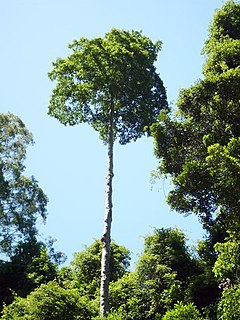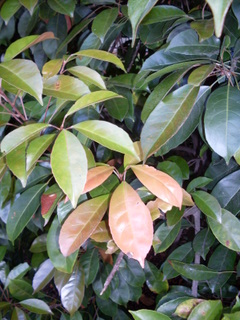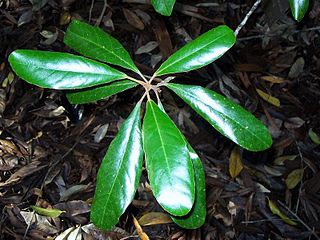
Elaeocarpus reticulatus, commonly known as blueberry ash, ash quandong, blue olive berry, fairy petticoats, fringe tree, koda, lily of the valley tree and scrub ash, is species of flowering plant in the family Elaeocarpaceae, and is endemic to eastern Australia. It is a shrub or small tree with oblong to elliptic leaves, racemes of white or pink flowers and blue, oval to spherical fruit.

Elaeocarpus grandis, commonly known as caloon, white quandong, blue quandong, silver quandong, blue fig or blueberry ash, is species of flowering plant in the family Elaeocarpaceae and is endemic to eastern Australia. It is a large tree with buttress roots at the base of the trunk, oblong to elliptic leaves with small teeth on the edges, racemes of greenish-white flowers and more or less spherical blue fruit.

Elaeocarpus kirtonii, commonly known as silver quandong, white quandong, brown hearted quandong, brownheart, mountain beech, Mowbullan whitewood, pigeonberry ash, white beech or whitewood, is species of flowering plant in the family Elaeocarpaceae and is endemic to eastern Australia. It is a large rainforest tree with buttress roots, regularly toothed, narrow elliptic to narrow oblong leaves, racemes of white flowers and pale blue, oval fruit.

Elaeocarpus obovatus, commonly known as hard quandong, blueberry ash, whitewood, grey carabeen, freckled oliveberry or gray carrobeen, is a species of flowering plant in the family Elaeocarpaceae and is endemic to eastern Australia. It is a tree with buttress roots at the base of the trunk, egg-shaped to lance-shaped leaves with the narrower end towards the base, racemes of white flowers, and blue, oval fruit.

Elaeocarpus eumundi, commonly known as Eumundi quandong, or smooth-leaved quandong, is a species of flowering plant in the family Elaeocarpaceae and is endemic to north-eastern Australia. It is a mid-sized tree with egg-shaped to lance-shaped leaves, racemes of cream-coloured flowers and blue fruit. It grows in rainforest from the Cape York Peninsula in Queensland to north-eastern New South Wales.

Elaeocarpus williamsianus, commonly known as hairy quandong, is a species of flowering plant in the family Elaeocarpaceae and is endemic to a restricted area of north-eastern New South Wales. It is a small tree with lance-shaped leaves, racemes of greenish-white flowers and spherical blue fruit.

Elaeocarpus culminicola, commonly known as Michael's quandong, is a species of flowering plant in the family Elaeocarpaceae and is native to parts of Malesia and Australasia. It is a tree with wavy leaves with wavy or toothed edges, racemes of white, cream-coloured or pink flowers and more or less spherical fruit.
Elaeocarpus arnhemicus, commonly known as elaeocarpus, blue plum, bony quandony or Arnhem Land quandong, is species of flowering plant in the family Elaeocarpaceae and is native to northern Australia, New Guinea, Timor and certain other islands in the Indonesian Archipelago. It is a tree with narrow elliptic to lance-shaped or egg-shaped leaves with serrated edges, racemes of white or cream-coloured flowers and metallic blue fruit.
Elaeocarpus coorangooloo, commonly known as brown quandong or Coorangooloo quandong, is a species of flowering plant in the family Elaeocarpaceae and is endemic to north-east Queensland in Australia. It is a tree with elliptic leaves, white flowers with lobed petals, and spherical fruit.
Elaeocarpus elliffii, commonly known as mountain quandong, is a species of flowering plant in the family Elaeocarpaceae and is endemic to north-east Queensland. It is a tree, sometimes with buttress roots at the base of the trunk, narrow egg-shaped leaves often with large domatia, flowers with five white petals with lobed tips, and more or less spherical fruit.
Elaeocarpus ferruginiflorus is a species of flowering plant in the family Elaeocarpaceae and is endemic to north-east Queensland. It is a small to medium-sized tree, sometimes with buttress roots at the base of the trunk, elliptic to egg-shaped leaves, flowers with five white petals, and dark bluish-grey fruit.
Elaeocarpus foveolatus, commonly known as white quandong or northern quandong, is a species of flowering plant in the family Elaeocarpaceae and is endemic to Queensland. It is a medium-sized tree, sometimes with buttress roots at the base of the trunk, variably-shaped leaves with serrated edges, flowers with five petals often with a few short lobes or teeth on the tip, and elliptic to oval fruit.
Elaeocarpus grahamii is a species of flowering plant in the family Elaeocarpaceae and is endemic to north-east Queensland. It is a small to medium-sized tree, sometimes coppicing, with elliptic to egg-shaped leaves, flowers with five petals that have a frilled tip, and oval blue fruit.
Elaeocarpus johnsonii, commonly known as Kuranda quandong or Johnson's quandong, is species of flowering plant in the family Elaeocarpaceae and is endemic to north-east Queensland. It is a small to medium-sized tree, often with several main stems, elliptic to egg-shaped leaves with the narrower end towards the base, racemes of up to seven flowers, the petals with fringed lobes, and dark blue fruit.
Elaeocarpus largiflorens, commonly known as tropical quandong, is a species of flowering plant in the family Elaeocarpaceae and is endemic to Queensland. It is a medium-sized to large tree, sometimes with buttress roots at the base of the trunk, mostly elliptic leaves and reddish-brown flowers.
Elaeocarpus linsmithii is a species of flowering plant in the family Elaeocarpaceae and is endemic to north-east Queensland. It is a shrub with oblong to elliptic leaves, white or pale green flowers and oval fruit.
Elaeocarpus ruminatus, commonly known as brown quandong, caloon or grey quandong, is a species of flowering plant in the family Elaeocarpaceae and is endemic to Queensland. It is a tree with buttress roots at the base of the trunk, mostly more or less elliptic leaves, cream-coloured flowers with five petals that sometimes have a divided tip, and more or less spherical fruit.
Elaeocarpus sericopetalus, commonly known as hard quandong, blueberry ash, hard duandong or northern quandong, is a species of flowering plant in the family Elaeocarpaceae and is endemic to Queensland. It is a tree, sometimes with buttress roots at the base of the trunk, relatively large lenticels, oblong to elliptic leaves, creamy-white flowers with five petals, and deep red to almost black fruit.
Elaeocarpus stellaris is a species of flowering plant in the family Elaeocarpaceae and is endemic to north-eastern Queensland. It is a tree, sometimes with buttress roots at the base of the trunk, elliptic to egg-shaped leaves, small groups of flowers with greenish-yellow sepals and creamy-white petals, the fruit conatining a five-flanged stone.
Elaeocarpus thelmae is a species of flowering plant in the family Elaeocarpaceae and is endemic to north-east Queensland. It is a tree, often with buttress roots at the base of the trunk, egg-shaped to elliptic leaves with many hairy domatia, densely rusty-hairy flowers, and blackish, oval fruit.





